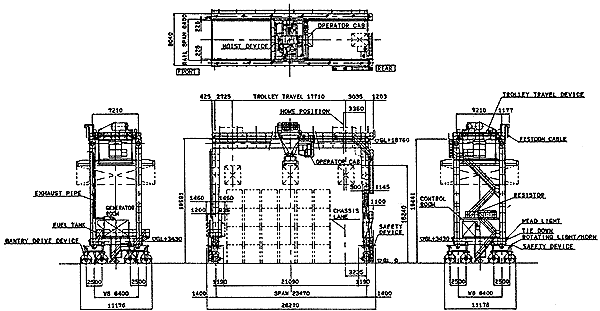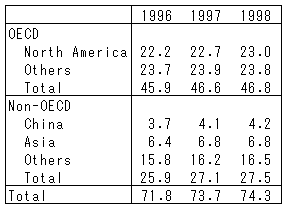Using this system, The RTG can move straight within ±30 mm meandering without the influence of the weather and the surface condition of a road. The RTG adopts the Vector-Inverter system instead of the previous Thyrister-Leonard system as the velocity control, gets the smooth positive and negative acceleration performance and the responsibility. In addition, the RTG has the rolling, small rotating and sliding system of the cargo hanging gear. This system can remember the three operating positions of the RTG. The operation board mounts switches efficiently, and is compact and simple. The RTG has the stairs from the ground to the operating room to keep the operators very comfortable.
As mentioned above, the RTG is operator-friendly, has the long-life and high controllability. It will contribute to the construction of the automatic terminal system that will advance in labor-saving and automation in future.
References
1) Kawasaki Technical Review Vol. 137(1998.4) pp. 114.

Fig. 8.1 General configuration of the Rubber Tired Transfer Crane (RTG)
[Nobukazu SHIMADA]
9. Fuels and Lubricating Oils
9.1 Fuels
9.1.1 Trend of Oil Demand1)2)
In 1998, the demands of oil went no further than 74.30 million BD (Table 9.1) which was increased by 0.8% compared with that in the previous year due to the currency crisis in Asian areas which have supported the world business and the effect by the warm winter over the world. The quantity of the crude oil production in the world in 1998 was increased by 3.0% compared with that in the previous year, and was increased in the Middle East, the Central/South America and the North America, decreased in Western Europe, and leveled off in other areas. (Table 9.2) There is a trend that the dependency on the Middle East is gradually increased.
Table 9.1 IEA World Oil Demand
Unit: 1 million barrel/day

Source: Oil Market Report as of January by OECD/IEA
Concerning the price, the upper limit of the production in OPEC was substantially increased by 2.47 million barrel after four years at the regular No. 103 OPEC General Assembly held in November, 1997, and amended to 27.50 million barrel/day.
BACK CONTENTS NEXT